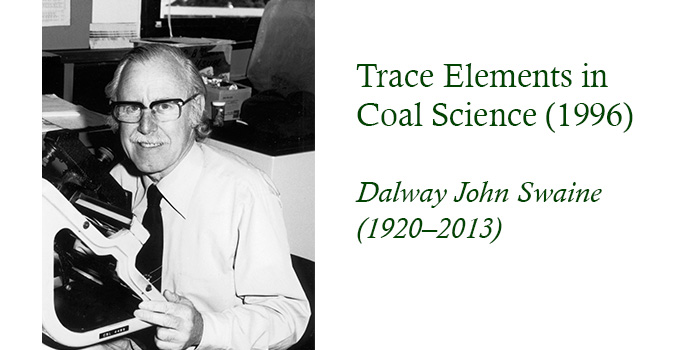30: Trace Elements in Coal Science (1996)
Abstract
Liversidge Research Lecture delivered before the Royal Society of New South Wales, 12th June, 1996. Reproduced by permission of the Royal Society of New South Wales from J. Proc. Roy. Soc. N.S.W., 1996, 129, 139-148.
"Trace elements are relevant to several aspects of coal science. Five topics are dealt with in detail, namely, the occurrence of trace elements, boron as an indicator of marine influence, boiler deposits, fluorine in coal, and the deposition of trace elements from the atmosphere. There is an increasing interest in the fate of trace elements from the combustion of coal for power production, especially environmental aspects of trace elements from the atmosphere and from ash disposal areas. Several suggestions for future work are outlined."
References
AS, 1989. Methods for the analysis and testing of coal and coke. Part 10.4 - Determination of trace elements - coal, coke and flyash - determination of fluorine content - pyrohydrolysis method. Standards Association of Australia, AS 1039.10.4 - 1989, 14 pp.
ASTM, 1979. Standard test method for total fluorine in coal by the oxygen bomb combustion/ion selective electrode method. American Society for Testing and Materials, D3761-79, 4 pp.
Beaton, A.P., Goodarzi, F. and Potter, J., 1991. The petrography, mineralogy and geochemistry of a Paleocene lignite from southern Saskatchewan, Canada. International Journal of Coal Geology, 17, 117-148.
Bowen, H.J.M., 1979. Environmental Chemistry of the Elements. Academic, London, 1st edition, 333 pp.
Branagan, D. and Holland, G., 1985 (Eds.). Ever Reaping Something New - a Science Centenary. University of Sydney, 1st edition, 256 pp.
Brown, H.R. and Swaine, D.J., 1964. Inorganic constituents of Australian coals. Journal of the Institute of Fuel, 37, 422-440.
Godbeer, W.C. and Swaine, D.J., 1987. Fluorine in Australian coals, Fuel, 66, 794-798.
Godbeer, W.C. and Swaine, D.J., 1995. The deposition of trace elements in the environs of a power station. In Environmental Aspects of Trace Elements in Coal, pp. 178-203 (D.J. Swaine and F. Goodarzi, Eds.). Kluwer, Dordrecht.
Godbeer, W.C., Swaine, D.J. and Goodarzi, F., 1994. Fluorine in Canadian coals. Fuel, 73, 1291-1293.
Goodarzi, F. and Swaine, D.J., 1994a. Paleoenvironmental and environmental implications of the boron content of coal. Geological Survey of Canada, Bulletin, 471, 76 pp.
Goodarzi, F. and Swaine, D.J., 1994b. The influence of geological factors on the concentration of boron in Australian and Canadian coals. Chemical Geology, 118, 301-318.
Le Fèvre, R.J.W., 1968. The establishment of chemistry within Australian science - contributions from New South Wales. In A Century of Scientific Progress, pp. 332-378, Royal Society of New South Wales, Sydney, 1968.
Swaine, D.J., 1962a. Boron in New South Wales coals. Australian Journal of Science, 25, 265-266.
Swaine, D.J., 1962b. The Trace-Element Content of Fertilizers. Commonwealth Bureau of Soils, Harpenden, 306 pp.
Swaine, D.J., 1971. Boron in coals of the Bowen Basin as an environmental indicator. Geological Survey of Queensland, Report 62, 41-48.
Swaine, D.J., 1977. Trace elements in coal. In Trace Substances in Environmental Health - XI, pp. 107-116. D.D. Hemphill (Ed.), University of Missouri, Columbia.
Swaine, D.J., 1989. Environmental aspects of trace elements in coal. Journal of Coal Quality, 8, 67-71.
Swaine, D.J., 1990. Trace Elements in Coal. Butterworths, London, 294 pp.
Swaine, D.J., 1992a. The organic association of elements in coals. Organic Geochemistry, 18, 259-261.
Swaine, D.J., 1992b. Guest editorial: Environmental aspects of trace elements in coal. Environmental Geochemistry and Health, 14, 2.
Swaine, D.J., 1994. Trace elements in coal and their dispersal during combustion. Fuel Processing Technology, 39, 121-137.
Swaine, D.J., 1995. The formation, composition and utilisation of flyash. In Environmental Aspects of Trace Elements in Coal, pp. 204-220. D.J. Swaine and F. Goodarzi (Eds.) Kluwer, Dordrecht.
Swaine, D.J. and Goodarzi, F., 1995 (Eds.). Environmental Aspects of Trace Elements in Coal. Kluwer, Dordrecht, 324 pp.
Swaine, D.J. and Taylor, G.F., 1970. Arsenic in phosphatic boiler deposits. Journal of the Institute of Fuel, 43, 261.
Swaine, D.J., Godbeer, W.C. and Morgan, N.M., 1989. The deposition of trace elements from the atmosphere. In Trace Elements in New Zealand: Environmental, Human and Animal, pp. 1-10. R.G. McLaren, R.J. Haynes and G.P. Savage, (Eds.). New Zealand Trace Elements Group, Lincoln.

